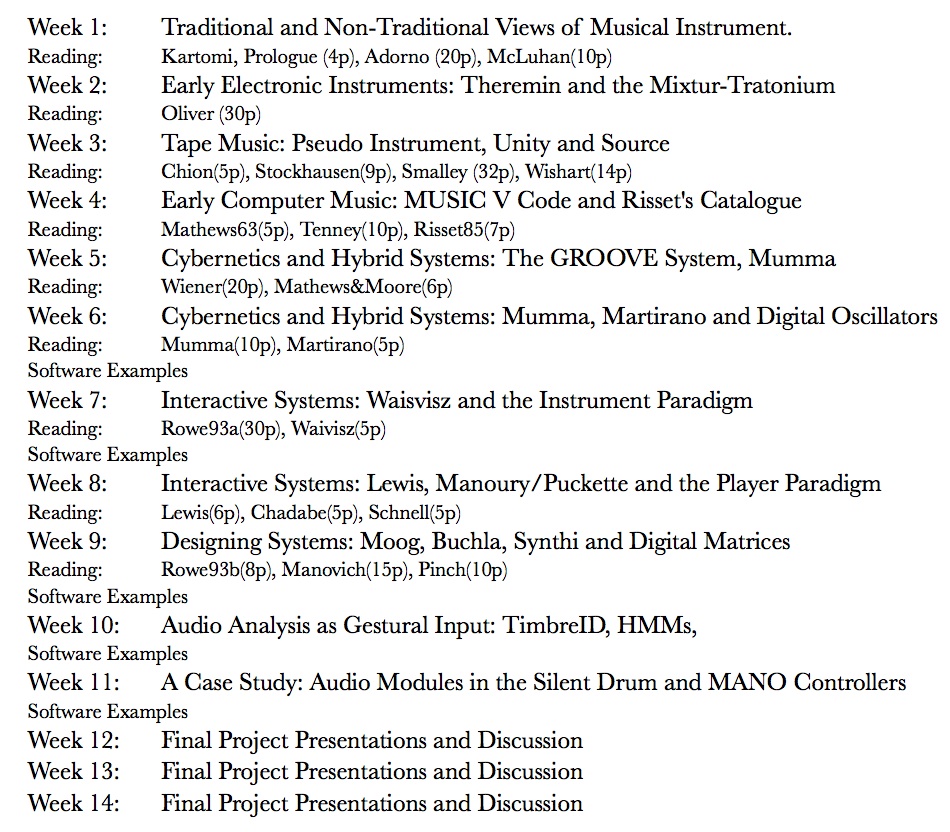CourseNo: MUSIW4626_001_2013_1
Meeting Location: PRENTIS HALL 320
Meeting Time: T 11:10A-01:00P
Instructor Information: Jaime E Oliver La Rosa
Rationale:
Electronic and Computer Music practices are often conceptualized in opposition to “acoustic” musical practices. Accordingly, the term musical instrument is generally taken to mean acoustic instrument, and in consequence, the characteristics of acoustic instruments and the practices associated with them, determine the dominant belief of what a musical instrument is. Nevertheless, since the very first practices of electronic music in the 20th century until the latest explorations in the digital domain, composers have recurrently used the term instrument to describe a wide variety of practices that combine performance interfaces, electronic circuits, and computer software.
This course will introduce students to these “other” kinds of musical instruments using two complementary perspectives. The first perspective focuses on analyzing various documents (text, sketches, audio, video) left by composers, performers, improvisers and programmers to determine why they conceived of their work as a musical instrument and how their conceptions challenge or extend the traditional concept of musical instrument. The second perspective involves software implementations of these “systems” and attempts to extract design principles that can be applied in broader contexts..
This course intends to provide historical examples of innovative musical systems to encourage students to design their own systems. It therefore provides an opportunity to apply the techniques learnt in lower level courses in a more comprehensive context.
Description
A central aspect of composing with computer media is designing the software system with which we will work; in other words, the composer, performer and/or improviser is often responsible for designing and assembling his own instrument. Electronic and Computer Music practices challenge our views of what a musical instrument is and how it’s expected to behave. Through the analysis of diverse documents by a wide range of musicians as varied as Theremin, Schaeffer, Stockhausen, Mathews, Moore, Tenney, Risset, Buchla, Moog, Mumma, Martirano, Lewis, Waisvisz, Manoury, Rowe, and Puckette amongst others, we will attempt to understand what new conceptions of musical instrument may have emerged with electric and digital media, and explore software implementations of some of their designs.
This is not a hardware hacking course, but a space to analyze and reflect on the “architectures” of historical music performance systems and the music made with them. Understanding these systems, and their context, will provide us with valuable design paradigms that we can apply to our own work. As a case study, I’ll show the global design on my own performance systems.
There are two options for a final project, both of which need to be formally presented in class: (1) A research paper related to the subject of the course, or (2) the creation of a tool, a new or modified composition or interactive performance system, accompanied by a short paper. It is desirable that students have some programming skills, and this is necessary if they are to develop a system of their own. However, it is not necessary that students are expert programmers. Final projects will be scaled and tailored according to each student’s skills and needs. Although the programming examples shown in class will be in Pure Data (Pd), students can develop their own projects in the platform of their choice.
Prerequisites:
MUSI V2205 or Consent of Instructor.
Grading:
Assignments / Periodic Assessments: 50%
Participation: 10%
Final paper / project: 40%
The instructor will hold bi-weekly meetings with each student to assess the evolution of their project and suggest possible directions of research, design, or programming. In these meetings, the instructor will grade the students progress and give them feedback on their grade and project.
The final paper / project will be presented in class. The grade given to it will not only reflect the quality of the project, which will be assessed throughout the semester, but also the quality and clarity of the presentation. These skills are extremely important for conference presentations and job presentations.
Syllabus
